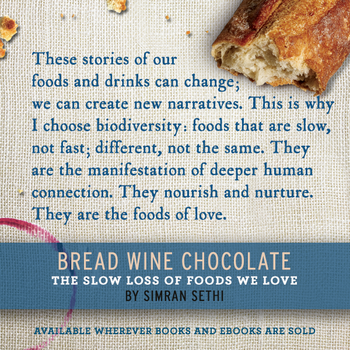As we celebrate holidays defined by feasting, one question comes to mind: What truly nourishes us?
The world is hungry. Amid staggering amounts of food waste (30-40 percent of what we cultivate) and increasing numbers of people suffering from health problems that are the result of being overweight, not under (2 billion people versus 795 million), we continue to suffer from malnutrition. We are, what author Raj Patel calls, "stuffed and starved."
But this malnourishment extends well beyond calories. Over the last century, the world has experienced the slow but steady loss of agricultural biodiversity -- a reduction of diversity in everything that makes our meals possible (what's known in scientific parlance as "genetic erosion"). Despite aisles of floor-to-ceiling choices in supersized supermarkets, recent studies show the world's diet trends toward just a handful of crops: rice, corn, wheat, potatoes, soybean and palm oil. These foods make up the "global standard diet" and are what we all eat now -- the same types and the same amounts.
The choices we see in flavors and brands are an illusion of diversity. From soil to seed to pollinator, from plant to fish to animal, every strand of our food web is threatened.
The consolidation of our food supply strips away not only diverse types and varieties of foods, but the wisdom behind cultivating and cooking them. Industrialized, monoculture approaches to agriculture don't require specialized knowledge borne out of deep connection to the land -- or the saving or sowing of traditional seeds. They demand what grows quickly and force a cookie-cutter, mostly one-size-fits-all approach to farming that depends upon chemical cocktails to nourish the soil and ward off pests and diseases. This homogeneity also extends into the staggering amount of prepackaged foods the world now eats.
I'm no stranger to this. I, too, long for more time to do everything, and cooking is an area of my life where I take shortcuts. But this loss comes at a price -- one that is hidden in feedlots, buried in beehives, and slowly, day-by-day, endangering foods and compromising our ability to nourish ourselves. Our collective orientation toward supersized sameness -- where we consume the same foods from Chicago to Shanghai--erodes not only agricultural inputs and traditions; it erases the richness of human experience and the stories of who we are.
Every area of the world suffering from the loss of biodiversity is also witnessing the disappearance of indigenous languages. Seed by seed, word by word, these tastes and traditions disappear -- a cultural erosion that accompanies the genetic one.
Despite claims to the contrary, industrialized agriculture isn't required for global sustenance. According to research from the Food and Agriculture Organization of the United Nations, small-scale farmers feed the world, producing 70 percent of what the population eats. Hilal Elver, the United Nations Special Rapporteur on the Right to Food, adds, "It should not be acceptable to endure the tribulations of mass hunger and malnutrition while the world has the capacity to produce enough healthy food for 12 billion people." Globally, farmers produce more than 1.5 times enough food to feed everyone on the planet; yet we are still malnourished, starved for access and resources to buy food.
Slowly, this system has also contributed to a deeper kind of erosion -- one of the spirit. It is the gradual but steady wearing away of the self -- numbed and distracted with screens, food, busyness, whatever we hope will alleviate the gnawing hollow inside us. The erosion -- the depletion -- outside of us also exists within.
We stuff. We starve.
But longing and pain give us an opportunity to change and to understand. To return to ourselves as we return to the earth. To rediscover our abundance and richness, celebrating the wellspring of natural resources within and outside of us.
The microcosm of the meal holds our collective hopes, dreams, sweat and tears. With every morsel, we have the chance to stem these erosions and reseed -- to nourish and honor each other as we also heal the planet. That is what this season of feasting offers: an occasion to remember our interconnection and savor the intimacy of food. Experiencing, with each meal, how the world feeds us. How we feed each other.
"Eating with the fullest pleasure -- pleasure, that is, that does not depend on ignorance -- is perhaps the profoundest enactment of our connection with the world," explains farmer/philosopher Wendell Berry. "In this pleasure we experience and celebrate our dependence and our gratitude, for we are living from mystery, from creatures we did not make and powers we cannot comprehend."
The stories of our foods and drinks can change; we can create new narratives. This is why I choose biodiversity: foods that are slow, not fast; different, not the same. They are the manifestation of deeper human connection. They nourish and nurture. They fill us up -- and we are truly fed.
Journalist and educator Simran Sethi's new book, Bread, Wine, Chocolate: The Slow Loss of the Foods We Love, is about the rich history--and uncertain future--of what we eat. The book traverses six continents to uncover the loss of biodiversity, told through an exploration of the senses and the stories of bread, wine, coffee, chocolate and beer. It was recently featured on The Huffington Post.
